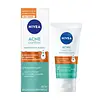What's inside
What's inside
 Key Ingredients
Key Ingredients

No key ingredients
 Benefits
Benefits

 Concerns
Concerns

 Ingredients Side-by-side
Ingredients Side-by-side

Water
Skin ConditioningGlycerin
HumectantTapioca Starch
Dimethicone
EmollientCetearyl Alcohol
EmollientSalicylic Acid
MaskingCarnitine
CleansingGlycyrrhiza Inflata Root Extract
Skin ConditioningMaris Sal
Skin ConditioningSodium Hyaluronate
HumectantGlycyrrhiza Glabra Root Extract
BleachingPEG-150 Distearate
EmulsifyingDecylene Glycol
Skin ConditioningSodium Stearoyl Glutamate
CleansingAmmonium Acryloyldimethyltaurate/Vp Copolymer
Acrylates/C10-30 Alkyl Acrylate Crosspolymer
Emulsion StabilisingXanthan Gum
EmulsifyingHydroxyethylcellulose
Emulsion StabilisingTrisodium EDTA
Phenoxyethanol
PreservativeSodium Hydroxide
BufferingSodium Chloride
MaskingDisodium Phosphate
BufferingSodium Phosphate
BufferingParfum
MaskingWater, Glycerin, Tapioca Starch, Dimethicone, Cetearyl Alcohol, Salicylic Acid, Carnitine, Glycyrrhiza Inflata Root Extract, Maris Sal, Sodium Hyaluronate, Glycyrrhiza Glabra Root Extract, PEG-150 Distearate, Decylene Glycol, Sodium Stearoyl Glutamate, Ammonium Acryloyldimethyltaurate/Vp Copolymer, Acrylates/C10-30 Alkyl Acrylate Crosspolymer, Xanthan Gum, Hydroxyethylcellulose, Trisodium EDTA, Phenoxyethanol, Sodium Hydroxide, Sodium Chloride, Disodium Phosphate, Sodium Phosphate, Parfum
 Reviews
Reviews

Ingredients Explained
These ingredients are found in both products.
Ingredients higher up in an ingredient list are typically present in a larger amount.
Glycerin is already naturally found in your skin. It helps moisturize and protect your skin.
A study from 2016 found glycerin to be more effective as a humectant than AHAs and hyaluronic acid.
As a humectant, it helps the skin stay hydrated by pulling moisture to your skin. The low molecular weight of glycerin allows it to pull moisture into the deeper layers of your skin.
Hydrated skin improves your skin barrier; Your skin barrier helps protect against irritants and bacteria.
Glycerin has also been found to have antimicrobial and antiviral properties. Due to these properties, glycerin is often used in wound and burn treatments.
In cosmetics, glycerin is usually derived from plants such as soybean or palm. However, it can also be sourced from animals, such as tallow or animal fat.
This ingredient is organic, colorless, odorless, and non-toxic.
Glycerin is the name for this ingredient in American English. British English uses Glycerol/Glycerine.
Learn more about Glycerin